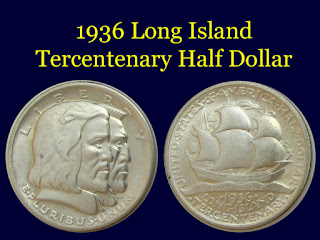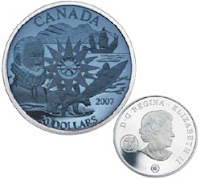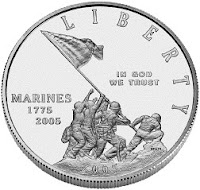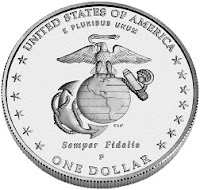May 17, 2008 | commemorative, legislative, US Mint
In a rare display of overwhelming bipartisan support, the House of Representatives passed three numismatic related bills. One was the Saint-Gaudens Double Eagle Ultra-High Relief Bullion Coin Act that was passed 415-0 (18 not voting) that will allow the US Mint to strike the high relief 24-karat gold coins featuring the Augustus Saint-Gaudens Double Eagle design.
On a vote of 403-8 (22 not voting), the House passed H.R. 5872, Boy Scouts of America Centennial Commemorative Coin Act. If passed by the Senate and signed by the President, this bill will authorize the Mint to strike one dollar proof and uncirculated silver coins to commemorate the 100th Anniversary of Scouting in the United States in 2010. The bill stipulates that the coins can be only struck at one Mint facility and would be distributed starting February 8, 2010. A $10 surcharge will be added to the price of the coins that will be paid to the National Boy Scouts of America Foundation.
Scouting started in 1907 in England. To celebrate the 100th anniversary of the scouting movement, the Royal Mint produced a beautiful commemorative coin and associated products.
In 1814, Baltimore attorney Francis Scott Key joined Colonel John Stuart Skinner aboard the HMS Tonnant to negotiate a prisoner exchange for Dr. William Beanes, a Maryland resident who was captured during the British attack on Washington, DC. After Key and Skinner dined with the ship’s senior officers, the three men were not allowed to return to Baltimore. That evening, the British spent part of 25-hours bombing Fort McHenry in the Baltimore Harbor.
In the morning, Key awoke to the view of the flag still flying over Fort McHenry. This inspired Key to write the four-stanza poem “The Defense of Fort McHenry“ which he said should be sung to the tune of The Anacreontic Song.
Over the years, the poem’s popularity would gain and then wane. On July 27, 1889, Secretary of the Navy Benjamin F. Tracy signed a general order making “The Star-Spangled Banner” the official song to be played when raising the flag.
In 1916, President Woodrow Wilson signed an executive order to have the “Star-Spangled Banner” be played by the military and for other “appropriate occasions.” After a controversy brewed when a cartoon announced, “Believe It or Not, America has no national anthem,” President Herbert Hoover signed the law making it the official National Anthem in 1931.
To honor the bicentennial of the War of 1812 and Key’s poem that became our national anthem, the House passed H.R. 2894, Star-Spangled Banner and War of 1812 Bicentennial Commemorative Coin Act. The bill calls for one-ounce proof and uncirculated silver coins designed to be “emblematic of the War of 1812 and particularly the Battle for Fort McHenry that formed the basis for the ‘Star-Spangled Banner’.“ Coins will be issued during 2012. The $10 surcharge will be paid to the Maryland War of 1812 Bicentennial Commission to help in its role of providing education, research, and celebrating the bicentennial of the War of 1812.
All of these bills must be passed by the Senate and signed by the President before they become law.
May 9, 2008 | commemorative, legislative, medals
On Tuesday, the White House announced that President George W. Bush signed H.R. 4286 to award the Congressional Gold Medal to Daw Aung San Suu Kyi, Burma’s prime minister-elect who has been under house arrest for the past six years. The enrolled bill was sent to the President on May 1, President Bush singed the bill after the recent natural disaster in the country now called Myanmar and the problems with trying to get aid to the people posed by the current military government.
Aung San Suu Kyi is the 1991 Nobel Peace Prize recipient for her work on behalf of the Burmese people. When award the $1.3 million prize, Ms. Suu Kyi used the money to establish a health and education fund for Burma. She is the only Nobel Peace Prize winner imprisoned. Congress will present her with the gold medal to recognize her commitment to peace, nonviolence, human rights and democracy in Burma.
H.R. 4286 call for the Secretary of the Treasury to “shall strike a gold medal with suitable emblems, devices, and inscriptions.” The Secretary can also strike duplicate bronze and gold medals for sale to the public at a price to be determine. Proceeds from the sale of duplicate medals will be deposited in the US Mint Public Enterprise Fund.
Apr 3, 2008 | coins, commemorative, legislative
On April 1, 2008, the House of Representatives passed HR 2040, Civil Rights Act of 1964 Commemorative Coin Act by a voice vote. If the bill passes the Senate and is signed by the president, the bill authorizes the US Mint to issue a one-dollar silver commemorative coin to honor the fiftieth anniversary of the passage of the Civil Rights Act of 1964 in 2014.
Although the bill does not specify a design or a theme, the bill requires the Mint to undergo the same bureaucratic review by the Commission of Fine Arts and the Citizens Coinage Advisory Committee. It is possible that a different design could be used for the proof and uncirculated coins.
Sales of these coins will include a $10 surcharge that will be given to the United Negro College Fund.
HR 2040 was introduced by Rep. John Lewis (D-GA) in April 2007. In the year since its introduction, the bill gained 313 co-sponsors . Because of the number of bipartisan co-sponsors and the work of Barney Frank (D-MA), Chairman of the Financial Services Committee, to work with Ways and Means Committee Chairman Charlie Rangel (D-NY), the bill was brought to the floor without committee hearings. The forty minute debate included accolades to the people who worked on getting this bill to the floor including Rep. David Scott (D-GA).
Now the bill goes to the Senate for their consideration. The Senate may choose to act on the House version or may consider S. 1437 was introduced in May 2007 by Sen. Debbie Stabenow (D-MI) with 13 cosponsors. It would be unlikely that the Senate will vote on their version since both versions are identical. Passing both versions would force the congress to form a conference committee to reconcile any differences and send it back to the chambers for up-or-down votes. That is too much work for an idea that should pass without further discussion.
Feb 3, 2008 | coins, commemorative
In 1636, the area we know as Long Island was settled by Algonquin tribes who settled there to escape more war-like tribes. The Algonquin call the island Paumanok, meaning “The Island that Pays Tribute.” On the arrival of the first Dutch settlers, they negotiated for a section of land just off of what we know as Jamaica Bay. They called the land Lange Eylandt (Long Island) in reference to its 118 mile length, and their settlement was named Breuckelin after a town in Holland. It was the first European settlement on the island.
By 1640, the English Puritans started settling the eastern end, coming down from New Haven, Connecticut. Subsequently, the English began to assert dominion over the region and claimed the propriety. In 1694, the English renamed the land as Long Island, the original Dutch Settlement became Brooklyn, and the Dutch colony founded on Manhattan Island was renamed as New York.
After 300 years, the United States was in a depression but collectors were being inundated with commemorative coins. In 1936, 16 new designs were issued and five others had not reached their authorized mintage. However, the Long Island Tercentenary Committed lobbied for a commemorative coin to coincide with the 300th anniversary of the first European settlement in May, 1936. But the bill allowing the mintage of 100,000 coins was not passed until April 13 of that year.
 The coin was designed by Howard Kenneth Weinman, the son of Adolph A. Weinman. To honor the settlement, the obverse features a right-facing bust of a Dutch colonist overlapping a bust of an Algonquin tribesmen. The reverse features a 17th-century ship under full sail traveling over a rolling sea. Because maps showed west-to-east passages as being from right-to-left, critics noted that the right-facing ship appeared to be heading back to Holland. Howard Weinman’s placed his initials under the the Algonquin’s chin by placing an H atop of the letter W, which was similar to the way his father included AW on his coin designs. In passing, the monogram could be mistaken for the elder Weinman’s.
The coin was designed by Howard Kenneth Weinman, the son of Adolph A. Weinman. To honor the settlement, the obverse features a right-facing bust of a Dutch colonist overlapping a bust of an Algonquin tribesmen. The reverse features a 17th-century ship under full sail traveling over a rolling sea. Because maps showed west-to-east passages as being from right-to-left, critics noted that the right-facing ship appeared to be heading back to Holland. Howard Weinman’s placed his initials under the the Algonquin’s chin by placing an H atop of the letter W, which was similar to the way his father included AW on his coin designs. In passing, the monogram could be mistaken for the elder Weinman’s.
Since 2008 will be the year I concentrate my collecting on items related to the areas once called New Amsterdam and Lange Eylandt, it was time to find a nice Long Island Tercentenary commemorative for the collection, I wanted to find a nice, even colored, mint state example. With a net mintage of 81,773 coins sold during the year after its release, I knew I would be able to find a nice example. The one I found was graded as MS60 by the dealer and purchased for a good price. It is a beautiful coin to add to the growing New York/Long Island collection.
Jan 11, 2008 | BEP, coins, commemorative, currency, US Mint
Happy 2008 from me and your US Mint. For this year, I will continue to write about what interests me and the US Mint is trying to adjust to an every increasing set of product offerings. I also want to give a shout out to the Bureau of Engraving and Printing for jumping on the new product bandwagon. So let’s first take look at the Mint.
With a price increase of $2, the US Mint began sales of the American Silver Eagle Proof coin on January 3. US law prevents the US Mint cannot from selling or distributing coins with a future date, but it does not prevent them from striking the coins in preparation. So these coins are being shipped as they are sold. I believe that is the earliest in the year that the Mint has delivered a current year coin.
You can order the Bald Eagle Commemorative coins beginning on January 15. The Bald Eagle Commemorative will have three different designs on a $5 gold coin, silver dollar, and clad half-dollar. Coins will be available as Proof and Uncirculated coins that can be purchased individually, as a three coin proof set, a “Young Collector’s Set” with an uncirculated half-dollar and other educational material, and a coin & medal set featuring an uncirculated silver dollar and a bronze Bald Eagle Medal from the National Wildlife Refuge System Centennial Medal Series. See the Mint’s announcement for complete list of products, mintage limits, and prices.
Sales of bags and rolls of 2008 Kennedy Half-Dollars and Sacagawea Dollars will begin on January 17. These coins will not see circulation because there is no demand for them. But since the Mint is legally required to strike these coins, they will be offered to collectors.
Sales of the 50 State Quarters usually begins earlier than other proof sets. So get ready for the last of the 50 state proof coins on January 24. The program has been extended one year to include the District of Columbia and the five territories of the United States.
Not to be out done, the BEP is selling the second issue of the Americana Series with the release of the intaglio print for the 53rd Florida United Numismatics (FUN) show in Orlando this weekend.
Also released on January 10 are the 2004 $20 Single Note for the federal reserve districs of Atlanta, Boston, New York, and Philadelphia. The notes in this set are those with the lowest possible serial numbers that are packaged in an archival sleve placed in a folder representing the federal reserve district. Each folder is $45 and the entire 12 note series can be bought as a subscription for $479.95.
Taking their cue from their friends at the US Mint, BEP “is excited to celebrate the year 2008 by offering the 2008 $2 Single Note.” This product is a Series 2003A Federal Reserve Note from the Atlanta federal reserve district with the serial number beginning with “2008.” Since the serial number is eight digits followed by the letter designating the federal reserve district, there will only be 10,000 notes for this product (20080000D through 20089999D). Each folder will cost $7.95. There is no indication that this type of collectible will be extended to other federal reserve districts.
Maybe the other notes whose serial number beginning with 2008 will be used for BEP’s Prosperity Line collection. The Prosperity Note Line features serial numbers beginning with 168 or 8888 which are significant in Chinese symbolism. On January 17, BEP will release the $2 Double Lucky Money Set. The set features two uncirculated $2 Federal Reserve notes. The serial number of one note will begin with “8888,” to symbolize good fortune, and “2008,” to commemorate the New Year. Both notes will feature serial numbers with matching last four digits. When released, the set will cost $48.88.
All this being introduced in January—with eleven months to go! Happy Collecting!
Dec 27, 2007 | coin design, coins, commemorative, legislative, RCM, Royal Mint, state quarters, US Mint
Around the end of November or the beginning of December, the numismatic year begins to wind down and we start to look ahead to the new year. As 2007 has entered its final week, December was a buys and interesting month with the voting for the People’s Choice Award for Coin of the Year, to the release of the 10th Anniversary Platinum Eagles, the release of a plethora of Presidential $1 Coin products by the US Mint, and congress doing good and bad with our money. But with a week to go in 2007, everyone is getting ready for 2008.
Looking ahead, this is the last year of the 50 States Quarters for the states—the District of Columbia and the territories will have quarters issued in 2009. Designs have been announced with Arizona and Alaska having the potential to be very good looking coins.
Designs for the four Presidential $1 Coins have been announced. For 2008, the new dollar coins will feature James Monroe, John Quincy Adams, Andrew Jackson and Martin Van Buren. It is apparent that the Mint engravers are using official portraits and other art to base the coin designs. This makes makes the portraits very pleasing and worthy of being on coinage. Along with the Presidential coins, the First Spouse gold coins will include Elizabeth Monroe, Louisa Adams, Andrew Jackson’s Liberty, and Martin Van Buren’s Liberty. Both Jackson and Van Buren were widowed when they served as president.
Speaking of dollar coins, 2008 begins the Native American $1 Coin program. From 2008 through 2016, the reverse of the Sacagawea “Golden” Dollar will be changed yearly commemorate an aspect of history of the native American people. It will be interesting to see how the Mint will handle the design of this coin with the built-in bureaucracy prescribed by law.
The first commemorative for 2008 will be the American Bald Eagle Recovery and National Emblem Commemorative Coin to honor of the recovery of the Bald Eagle species, the 35th anniversary of the Endangered Species Act of 1973, and the Bald Eagle’s importance as a national symbol. I cannot help from thinking that Benjamin Franklin wanted the turkey as the national symbol!
The Bureau of Engraving and Printing will release a redesigned $5 Federal Reserve Note with updated security features and a new purple color and a larger “5” on the reverse for the visually impaired. Sometime during 2008, BEP will introduce a redesigned $100 FRN with new security features and color. Because the BEP is not required to have its designs vetted by the Commission of Fine Arts, the new design will remain a secret until the BEP is ready to make their announcement.
Outside of the United States, the Royal Canadian Mint has started to introduce new non-circulating legal tender (NCLT) coins with new designs. The RCM is stressing new colors, designs, and the embedding of gemstones in their coins. Also, the 2010 Winter Olympics continues to be a significant theme of RCM coins.
Across the pond in the United Kingdom, the Royal Mint is advertising their new designs. New designs for legal tender coins are available from the Royal Mint whose sets include three commemorative coins honoring the 60th birthday of Prince Charles, the 450th anniversary of the accession of Queen Elizabeth I, and commemorating the 100th anniversary of the 4th Olympiad held in London.
Even The Perth Mint has issued its 2008 Silver Koala. This $1 NCLT silver coin is the second in the series of the Koala series introduced in 2007. The Perth Mint has also tried new coinage methods that includes moving parts and holograms.
It is going to be a very busy year and exciting year in numismatics.
Dec 12, 2007 | coin design, commemorative
Last week the US Mint announced the release of the designs for the 2008 American Bald Eagle Recovery and National Emblem Commemorative Coin. These commemorative coins are authorized under Public Law 108-486 [GPO: text/pdf], the American Bald Eagle Recovery and National Emblem Commemorative Coin Act, that authorizes the Mint to issue gold, silver proof, and uncirculated commemorative coins in honor of the recovery of the Bald Eagle species, the 35th anniversary of the Endangered Species Act of 1973, and the Bald Eagle’s importance as a national symbol.
According to the Mint:
The obverse of the $5 gold coin was designed by Artistic Infusion Program (AIP) Master Designer Susan Gamble and sculpted by United States Mint Medallic Sculptor Phebe Hemphill. The design depicts young eaglets perched on a branch in their natural habitat. The coin’s reverse, sculpted by United States Mint Sculptor-Engraver Don Everhart, depicts an image of the current Great Seal of the United States as engraved in 1903.
The obverse of the $1 silver coin, designed by AIP Master Designer Joel Iskowitz and sculpted by United States Mint Sculptor-Engraver Don Everhart, depicts a mature eagle soaring majestically through the sky. The coin’s reverse, sculpted by United States Mint Medallic Sculptor Jim Licaretz, is based on a replica of the first Great Seal of the United States used between 1782 and 1841.
The obverse of the half-dollar clad coin, designed by Susan Gamble and executed by United States Mint Medallic Sculptor Joseph Menna, depicts baby eaglets at about two to three days old, settled in a nest with an unhatched egg. AIP Associate Designer Donna Weaver designed the coin’s obverse, which features the legendary Bald Eagle “Challenger” with the American flag in the background. The design was executed by United States Mint Sculptor-Engraver Charles Vickers.
Line art versions of the approved designs are available on the US Mint’s website.
Oct 29, 2007 | CCAC, commemorative, US Mint
The US Mint announced that the Citizens Coinage Advisory Committee (CCAC) will hold a public meeting on November 13 at 9:00 AM (ET). CCAC Meetings are held at United States Mint Headquarters, 801 9th Street NW, Washington, DC. The agenda will include the presentation of new design candidates for the 2009 Abraham Lincoln $1 Silver Commemorative Coin.
Anyone interested in participating in the meeting should call 202-354-7502 for updated information on meeting time and location. Members of the news media are welcome. I wonder if bloggers count as news media?
Jul 23, 2007 | Canada, commemorative, history, RCM
 The Royal Canadian Mint is embroiled in a controversy with Inuit Tapiriit Kanatami, the Canadian organization representing four Inuit regions. This week, the RCM issued a $20 commemorative coin to mark the 125th anniversary of the establishment of research stations around the Arctic to share scientific data. It is referred to as the first international polar year. English explorer Martin Frobisher is featured on the reverse along with a 16th century ship and kayaker representing the Inuit people.
The Royal Canadian Mint is embroiled in a controversy with Inuit Tapiriit Kanatami, the Canadian organization representing four Inuit regions. This week, the RCM issued a $20 commemorative coin to mark the 125th anniversary of the establishment of research stations around the Arctic to share scientific data. It is referred to as the first international polar year. English explorer Martin Frobisher is featured on the reverse along with a 16th century ship and kayaker representing the Inuit people.
According to history, Frobisher lured an Inuit kayaker to his ship in order to bring him back to England for display. The Inuit are people indigenous of the Arctic regions of Canada and must have looked very different to the 16th century anglo-saxons from England. The captured Inuit died of disease in England.
ITK is asking the RCM to consult its organization when issuing coins about its people saying ignorance caused this mistake. The RCM is saying that they consulted experts and added the kayak as an acknowledgment of the Inuit being in the region and that it is not a commentary on those events. ITK is preparing a letter to the RCM about this coin.
Although I cannot find records of the RCM withdrawing coins, it is possible that they could cease the sale of this coin. Canada does have laws governing the fair treatment of people which could dictate what the RCM does. This is not a judgement on Canadian law. I am anticipating that if the coin does get withdraw, it will be a modern issue with a low mintage and an interesting history.
Time to go to the RCM website to order a few coins.
Image from the Royal Canadian Mint
Jul 11, 2007 | coins, commemorative, US Mint

 On July 2, the publisher of World Coin News announced that the 2005 Marine Corps 230th Anniversary Silver Dollar has been named “Coin of the Year” (COTY). This commemorative coin features an engraving by United States Mint Sculptor-Engraver Norman E. Nemeth of the Joe Rosenthal Pulitzer Prize winning photograph of the Marines raising the flag over Iwo Jima in 1943. The reverse features the official emblem of the Marine Corps engraved by United States Mint Sculptor-Engraver Charles L. Vickers.
On July 2, the publisher of World Coin News announced that the 2005 Marine Corps 230th Anniversary Silver Dollar has been named “Coin of the Year” (COTY). This commemorative coin features an engraving by United States Mint Sculptor-Engraver Norman E. Nemeth of the Joe Rosenthal Pulitzer Prize winning photograph of the Marines raising the flag over Iwo Jima in 1943. The reverse features the official emblem of the Marine Corps engraved by United States Mint Sculptor-Engraver Charles L. Vickers.
The US Mint issued their press release today.
Coin of the Year is selected from winners of ten categories. The Marine Corps commemorative was the winner of the “Best Crown” category. Other US coins in winning categories include the 2005 Oregon State Quarter as the “Best Trade Coin” and the 2005 American Bison Nickel as the “Most Popular” coin.
COTY was created by the editors of World Coin News to “encourage and honor creativity in the coinage issues of the mints of the world.” World Coin News delays the selection to allow coins to be nominated and reviewed.




